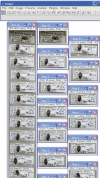InvertNet: a new paradigm for digital access to invertebrate collections
- PMID: 22859886
- PMCID: PMC3406474
- DOI: 10.3897/zookeys.209.3571
InvertNet: a new paradigm for digital access to invertebrate collections
Abstract
InvertNet, one of the three Thematic Collection Networks (TCNs) funded in the first round of the U.S. National Science Foundation's Advancing Digitization of Biological Collections (ADBC) program, is tasked with providing digital access to ~60 million specimens housed in 22 arthropod (primarily insect) collections at institutions distributed throughout the upper midwestern USA. The traditional workflow for insect collection digitization involves manually keying information from specimen labels into a database and attaching a unique identifier label to each specimen. This remains the dominant paradigm, despite some recent attempts to automate various steps in the process using more advanced technologies. InvertNet aims to develop improved semi-automated, high-throughput workflows for digitizing and providing access to invertebrate collections that balance the need for speed and cost-effectiveness with long-term preservation of specimens and accuracy of data capture. The proposed workflows build on recent methods for digitizing and providing access to high-quality images of multiple specimens (e.g., entire drawers of pinned insects) simultaneously. Limitations of previous approaches are discussed and possible solutions are proposed that incorporate advanced imaging and 3-D reconstruction technologies. InvertNet couples efficient digitization workflows with a highly robust network infrastructure capable of managing massive amounts of image data and related metadata and delivering high-quality images, including interactive 3-D reconstructions in real time via the Internet.
Keywords: Collection digitization; collection database; image processing.
Figures




References
-
- Ball J, Gross J, Gryzmala T, Nishida G, Oboyski P, Gillespie R, Roderick G, Will K. (2011) Calbug: a case study of digitization challenges for Entomology collections. Entomological Collections Network, Reno, Nov 2011. http://www.ecnweb.org/dev/files/talks_ecn_calbug_kwill2.ppt
-
- Beeler T, Bickel B, Beardsley P, Sumner P, Gross M. (2010) High-Quality Single-Shot Capture of Facial Geometry. Proceedings of ACM SIGGRAPH, ACM Transactions on Graphics 29(3): 40.1–40–9. http://graphics.ethz.ch/publications/papers/paperBee10.php
-
- Bertone MA, Deans AR. (2010) Remote curation and outreach: examples from the NCSU insect museum GigaPan project. Proceedings of the Fine International Conference on Gigapixel Imaging for Science, November 11–13 2010. http://www4.ncsu.edu/~ardeans/BertoneDeansFAFS.pdf
-
- Blagoderov V, Kitching I, Simonsen T, Smith VS. (2010) Report on trial of SatScan tray scanner system by SmartDrive Ltd. Nature Precedings. hdl:10101/npre.2010.4486.1 http://precedings.nature.com/documents/4486/version/1
-
- Eades DC, Otte D, Cigliano MM, Braun H. (2012) Orthoptera Species File Online. http://orthoptera.speciesfile.org/HomePage.aspx
LinkOut - more resources
Full Text Sources
